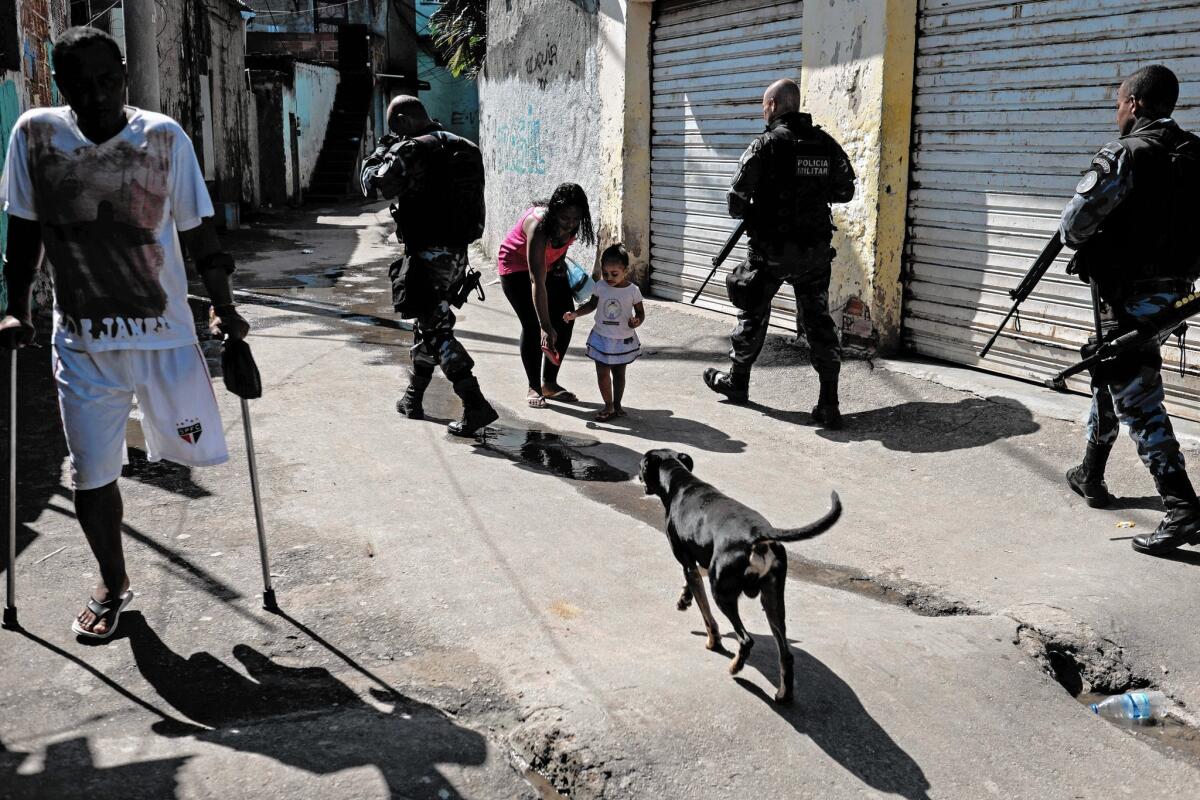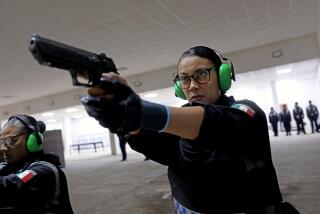In Brazil, homicide rate still high despite increased prosperity

Police patrol a shantytown in Rio de Janeiro. The number of killings in Brazil has dropped in larger, more affluent cities such as Rio but jumped in poorer areas.
- Share via
Reporting from Maceio, Brazil — Almost everyone here on the outskirts of Maceio, the capital of Brazil’s most dangerous state, has a horror story to tell.
“They shot a woman in the bar last week,” said Maria das Gracas da Silva, a 49-year-old maid. “They shot her right in her mouth, which usually means she said something she shouldn’t have. Then they just took off.”
Up the road, Francisco Kummer pointed at a nearby tree from inside his small school supplies shop.
“I’ve seen two murders recently, including one right here in front of my shop,” he said. “The men on the motorcycles weren’t actively looking for the guy, but they must have wanted him, because when they noticed him, they stopped abruptly. Three shots in the head.”
More than 2,000 people are killed each year here in the tiny state of Alagoas, with a population of a little more than 3 million, making it much more dangerous than big cities such as Sao Paulo and Brasilia. But the problem of killings is nationwide and has not improved for more than a decade.
Brazil’s high homicide rate has barely budged since 2000, even as economic growth has brought millions out of poverty and reduced social inequality.
A study by several United Nations agencies, including the World Health Organization, which used global data from 2012, the most recent year available, showed that Brazil had the highest number of killings in the world.
The nation’s death toll of more than 64,000 that year, according to the report, is comparable to the number of people who have been killed annually in Syria’s civil war. Brazil’s homicide rate remains higher than that of Mexico, despite the drug war raging there since 2006.
From 2000 to ‘12, Brazil experienced a period of relative stability and prosperity, with almost every social indicator improving. Except one.
“All else being equal, we expect that if there is a major drop in inequality, homicide rates go down,” said Christopher Mikton, technical officer on the WHO Prevention of Violence Team, who worked on the report. However, “in 2000, Brazil’s homicide rate was 32.2 per 100,000 residents, and in 2012 it was just over 32.4.”
“In the same period,” he said, “the world overall got about 16% safer from murder, while developed countries saw a drop of 40%.”
The Brazilian government offers a lower estimate of the number of killings, putting it at about 50,000 in 2012. About half the victims were young black men, local data indicate. There is no evidence of improvement since 2012.
Studies point to a broad set of possible explanations for the persistent violence. Experts cite the continued prevalence of the drug trade and violent gangs in certain neighborhoods, as well as corruption and poor training among police forces and ineffectiveness in the court system.
They say that despite social improvements, inequality is still high by global standards. The mega-rich live close to youths who lack educational and professional opportunities, and that increases the risk of crime.
“It’s essential that we change the justice system, socioeconomic conditions and the way that the police work,” said Sergio Adorno, a professor at the University of Sao Paulo and director of its Center for the Study of Violence. “The police continue to be very violent and the justice system is slow. They’re both relics of the past.”
There has been one significant shift in the last decade: The number of homicides has dropped in larger and more affluent cities, such as Sao Paulo and Rio de Janeiro, and jumped in the poorer northeastern region, which includes Alagoas.
Experts have no easy answers for the change. One theory is that some members of criminal gangs, such as Red Command, which was founded in Rio, have moved here as they have lost territory to security crackdowns and better policing at home. Another is that the number of young men — a demographic more likely to commit crimes — has grown.
The homicide rate increased in the northeast even as the region’s economy grew much faster than that of the southeast, which includes Sao Paulo and Rio.
Kummer, the shopkeeper, recalls that his closest brush with death came precisely when the economy took off in his neighborhood. He received threats after he complained to authorities about a booming nightclub nearby.
“All kinds of different people began to come up to me and give me messages and dark warnings,” he said as he looked out at joggers passing by a park where he witnessed a killing. “They’d say things like, “Watch out’ or ‘You don’t know who you’re dealing with,’ or most menacingly, ‘Stay safe.’”
For much of the last five years, Brazil’s violence churned along in the background, rarely interfering with the economic or political headlines that dominated here, unless it spilled into the lives of the white upper-middle class.
But the economy has slowed, and with President Dilma Rousseff weakened politically by scandals, newly empowered conservatives have gone on the offensive in Congress. They have brought crime to the center of the national debate by pressing for a law to try 16- and 17-year-olds as adults, a move that neither most crime experts nor the federal government believe would reduce violence.
During her reelection campaign last year, Rousseff proposed altering the constitution to allow more federal involvement in crime-fighting at the state level. This would be a big step toward allowing local authorities to work together effectively, said Regina Miki, the national secretary of public security.
“We’d like to able to bring all the relevant local authorities to the same table, establishing goals and streamlining enforcement and judicial processes, as well as provide education and training for the police,” said Miki, who acknowledges that the national homicide rate has not improved.
But Rousseff would need congressional support for any such changes, given that police and local security are under the jurisdiction of state governors.
Despite the violence, Miki pointed to Alagoas as successful test case for more federal involvement. After national intervention, the homicide rate came down to 64 per 100,000 people in 2012. Three years earlier, it was more than 100 per 100,000.
Jeovar da Oliveira Verissimo, 70, said he has watched generation after generation turn to crime and violence and is not yet convinced that things have turned around.
“Well, I guess maybe there’s been a small improvement, maybe I can smell some good things in the air,” he said, sitting on a bench across from a burned-down building previously used for selling drugs. “After all, it’s been a month or two since I’ve seen a murder around here.”
Bevins is a special correspondent.
More to Read
Sign up for Essential California
The most important California stories and recommendations in your inbox every morning.
You may occasionally receive promotional content from the Los Angeles Times.













